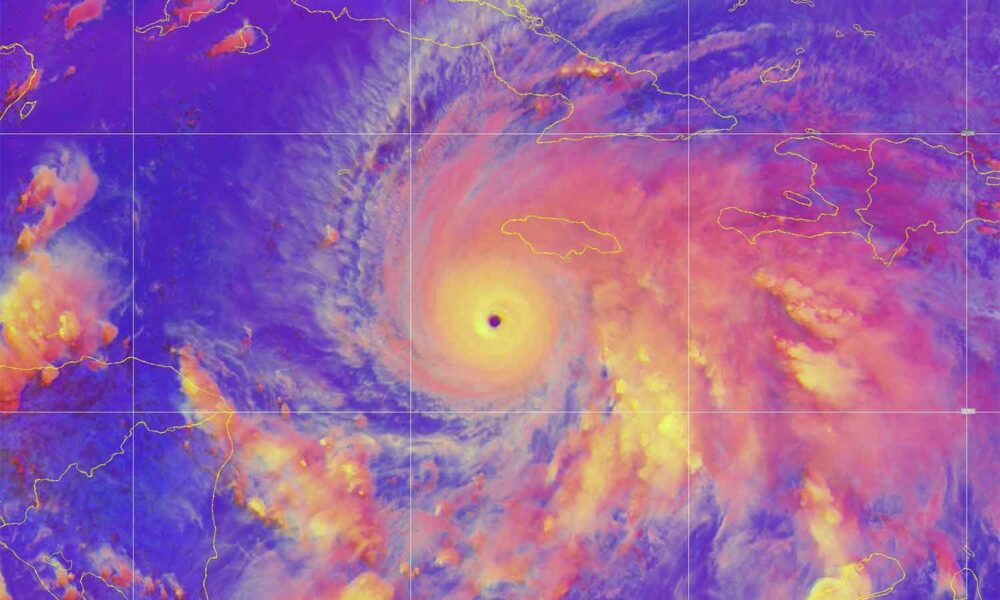Over the last week, we’ve watched with increasing alarm as Hurricane Melissa has gathered force, hyper-rapidly intensifying into a dangerous Category 5 hurricane that is bearing down on Jamaica, with huge risks to Haiti, Cuba, the Dominican Republic, and other nearby Caribbean nations. There is no question that this extraordinary record-breaking storm has been made significantly worse by human-caused climate change. People in its path will be contending with an extreme crisis in the days to come and an enormous human and economic toll in the foreseeable future.
Right now, the focus must be on safety and emergency preparedness. But let’s not forget that there are those to hold accountable for disasters like this: the policymakers and fossil fuel companies who have long obstructed climate action, lied about climate science, and left communities to face the destruction of extreme disasters.
Here are some key things to know about Hurricane Melissa and climate change and what it means for people in harm’s way.
An unusually dangerous storm made worse by climate change
It may seem like we’ve had a “quiet hurricane season.” That’s because there hasn’t been the number of catastrophic US landfalling hurricanes we saw last year (e.g. Beryl, Helene and Milton). But in fact, four out of the five hurricanes that formed this year (Humberto, Emily, Gabrielle, Melissa) became “major,” and all four of those underwent rapid intensification, an ominous sign of the heat building up in our oceans.
The Saffir-Simpson Hurricane Scale categorizes storms by their maximum sustained winds. Category 5 storms have winds of 157 mph or greater and are historically rare. There have only been two years since 1960—the start of the satellite era— with three or more category 5 hurricanes: 2005 and 2025, with Erin, Humberto, and now Melissa. Melissa’s hurricane-force winds extend outward up to 30 miles from its center, and tropical storm force winds extend outward up to 195 miles from its center, hence the impacts extending beyond Jamaica and Cuba into Haiti and the Dominican Republic.
Warm water is hurricane fuel and the Caribbean is warm—much warmer than usual. According to Climate Central, the elevated ocean surface temperatures below Melissa in recent days were made 700 times more likely by climate change. They go further to say: “These [ocean temperatures] are projected to have strengthened Melissa’s top wind speed by about 10 mph, increasing its potential damages by up to 50%”. Tragically, the storm is making landfall as a powerful Category 5 in a populated area of Jamaica.
Then there’s our warmer atmosphere. Warm air can hold more water than cool air, leading to more precipitation. As the atmosphere continues to warm, it acts like an expanding sponge, able to hold—and drop—more and more water. Any hurricane that forms today can tap into this to bring heavier rainfall wherever it moves.
The rainfall forecasts for Southwest Haiti, parts of Jamaica, and now eastern Cuba have been absolutely staggering, with feet of rain in the process of falling, or anticipated in coming days.

One of Hurricane Melissa’s most unusual features is its slow movement across the Caribbean. This slow pace may also be due to climate change: According to a recent modeling study, as climate change worsens, we can expect slower-moving hurricanes due to less circulation in the upper atmosphere, which normally acts to steer hurricanes along.
High risk of catastrophic impacts and huge existing vulnerability
The monstrous power of this storm is trained on people and terrain that are highly exposed and vulnerable to harms. The wide field of hurricane-force winds, long-duration heavy rainfall (up to 30 inches in some places) falling on already saturated ground, and significant storm surge (expected to be 9-13 feet in some areas), all pose catastrophic threats to Jamaica, Haiti, Cuba, the Dominican Republic, Bahamas and other parts of the Caribbean. The mountainous topography of some of these countries and the limited tree cover and rural poverty, most notably in Haiti, make the risk of landslides acute, threatening infrastructure, homes, and lives. There could also be long-lasting power and communications outages, roads and bridges could wash away, and remote communities may be cut off for days.
For people in harm’s way, it’s critical to follow their local emergency authorities’ advice to evacuate or shelter in place safely immediately. The reality is that with a storm this extreme, it will be hard to be completely shielded from harm, especially for those with fewer resources. The National Hurricane Center’s advisory messages are urgent and unequivocal in alerting people to the extreme dangers they face.

In a supreme injustice, the people and places in the path of this storm are among those who have contributed the least to the climate crisis and yet are on the frontlines of its deadly and costly consequences. In places like Haiti, poverty, political unrest and an ongoing humanitarian crisis increase people’s vulnerability to disasters like this.
Government authorities are doing what they can with constrained resources, including a massive evacuation effort underway in Cuba. Jamaica has been at the forefront of finding innovative ways to invest in disaster recovery and resilience, including a catastrophe bond (with a parametric trigger that will be met by Hurricane Melissa). This should hopefully provide quick access to funds for recovery and rebuilding after the storm.
But it’s not difficult to imagine that much more will be needed in Caribbean nations in the time to come, including humanitarian assistance on a vast scale. The United States should play a constructive role in that effort, instead of going down a path of military aggression in the region. If you are able, please look for ways to support Hurricane Melissa recovery efforts in the days to come.
Marc Alessi, Rachel Cleetus, Carlos Martinez, Astrid Caldas and Juan Declet-Barreto contributed to this blog post.

